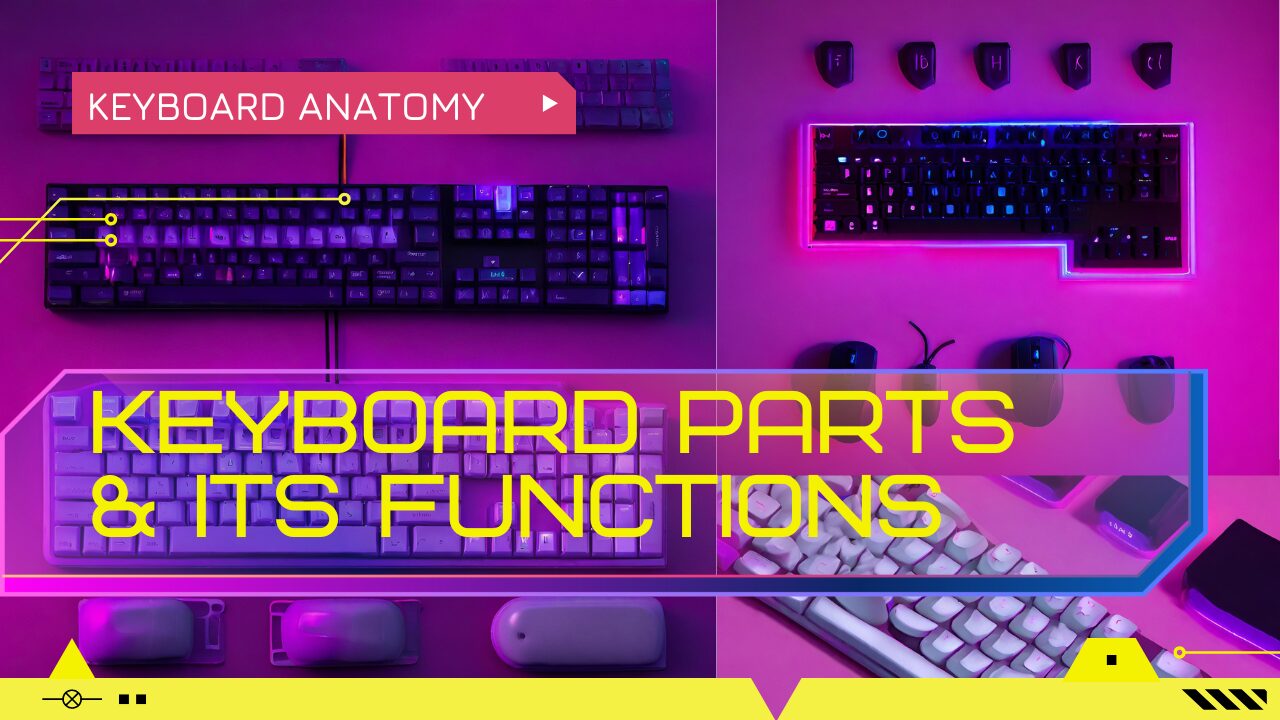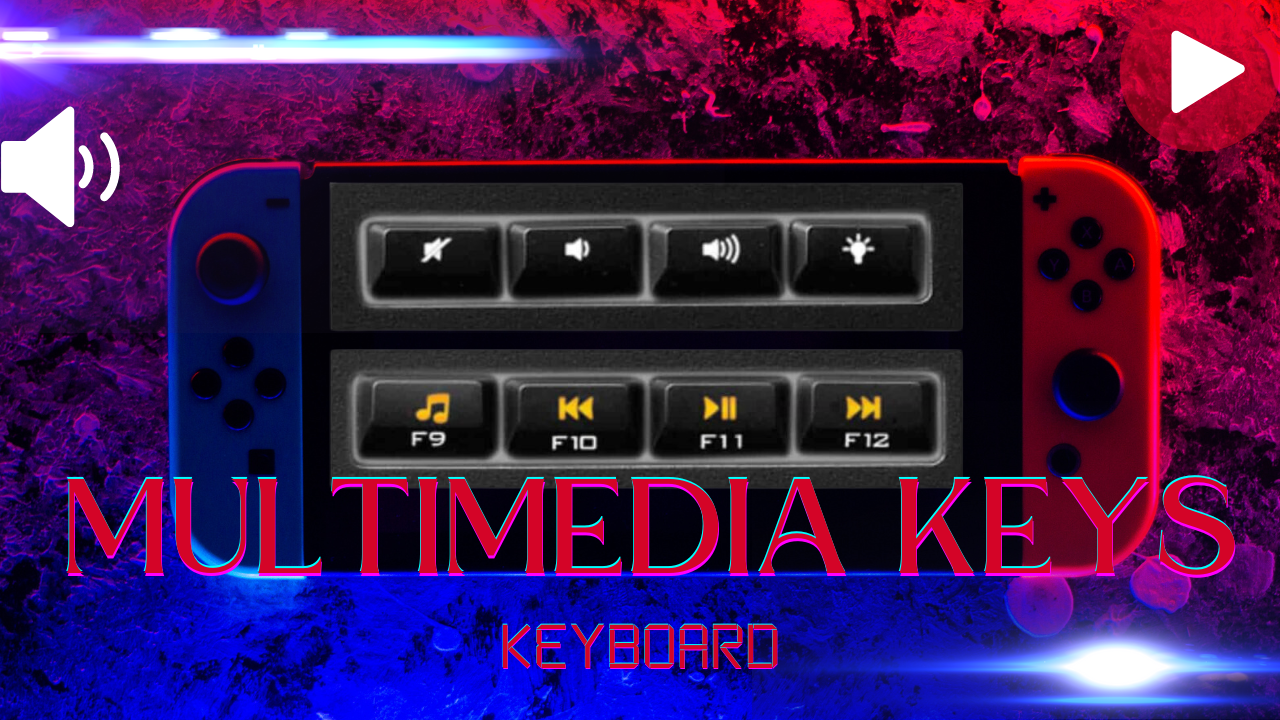Have you ever looked at a keyboard and wondered why some are bigger than others, with extra keys on the side or missing buttons entirely? Those differences are all about Keyboard sizes!
Just like shirts come in small, medium, and large, keyboards do, too. Understanding these different size keyboards can be a game-changer when choosing the perfect one for your needs.
Imagine typing a lengthy report on a tiny keyboard missing all the number keys – not ideal, right?
On the other hand, an oversized computer keyboard might take up too much precious desk space for someone who loves a minimalist setup. Knowing what each mechanical keyboard size offers will help you find a comfortable keyboard, save space, and have all the keys you need to type like a pro!
In this blog, we will explore different keyboard sizes, layouts, and structures, Compare charts of all keyboard sizes, and help you find the perfect fit for your needs.
Anatomy of a Keyboard — Terminology
Choosing a keyboard can be overwhelming, with so many options to consider. To choose the right keyboard, it’s essential to understand its parts. Let’s explore the anatomy of a keyboard, uncovering the secrets behind this everyday tool.
- Function Keys Row: Your Gateway to Shortcuts
The function keys row, typically located at the top of the keyboard, consists of F1 to F12 keys. These keys are often used for shortcuts, accessing specific application functions, or controlling multimedia playback.
- Modifiers: The Power Behind Key Combinations
Modifier keys, such as Shift, Ctrl, Alt, Alt Gr (only on ISO-layout keyboards), Cmd (on Mac keyboards), and Caps Lock, are combined with other keys to perform specific actions. For example, holding Shift while pressing a letter key produces an uppercase character.
- Alphas: The Backbone of Typing and Data Entry
The alphanumeric keys, or alphas, comprise the main section of the keyboard and include the letters A to Z, numbers 0 to 9, and punctuation symbols. These keys are used for typing, entering data, and performing various actions.
- Navigation and Arrow Keys: Your Guides Through the Digital Landscape
The navigation and arrow keys are typically between the alphas and the numpad. These include the arrow keys (up, down, left, right), Home, End, Page Up, and Page Down. They are used for navigating within documents, web pages, and applications.
- Numpad: A Dedicated Numeric Haven
The numpad is a separate numeric keypad on some keyboards’ right side. It consists of the numbers 0 to 9, arithmetic operators (+, -, *, /), and the Enter key. The numpad is specifically designed for data entry and numerical calculations.
- Homing Bar: Guiding Your Fingers Home
The homing bar is a horizontal raised bump or ridge on the F and J keycaps, designed to help users find the correct starting position for their fingers without looking at the keyboard.
By understanding the anatomy of a keyboard and the functions of its various components, you can make informed choices when selecting the keyboard that best suits your needs and preferences. Whether you’re a seasoned typist, a gamer seeking precise controls, or a programmer requiring a specialized layout, understanding keyboard anatomy empowers you to find the perfect tool for your digital era.
The Comparison Chart of Keyboard Sizes

Keyboard Sizes Comparison Table
This section will explore different keyboard sizes, layouts, and keyboard structures. Let’s dive into a helpful keyboard sizes chart to compare them.
| Keyboard Size | Keyboard Name | Typing & Control Keys | Number Keys | Arrow Keys | Function Keys | Editing Keys | Extra Features |
|---|---|---|---|---|---|---|---|
| 100% | Full-Sized | Comprehensive layout with all essential keys | Dedicated number row | Full-size arrow keys | Full set of function keys | Dedicated editing keys | None |
| 96% | Compact Full-Sized | Similar to full-sized, but with slightly reduced size | Dedicated number row | Full-size arrow keys | Full set of function keys | Dedicated editing keys | None |
| 80% | Tenkeyless | Typing and control keys, but without a dedicated number pad | There is no dedicated number row | Full-size arrow keys | Standard set of function keys | Dedicated editing keys | None |
| 75% | Compact Tenkeyless | Similar to 80%, but may retain a few keys from the number row | Compact number row (usually accessed by holding down a function key) | Full-size arrow keys | Standard set of function keys | Dedicated editing keys | None |
| 65% | Compact | Minimalistic design with a focus on essential keys | Classic set of function keys | Smaller arrow keys | There is no dedicated number row | Some editing keys may be combined with other keys | None |
| 60% | Mini | Most compact layout, with only the most essential keys | A limited set of function keys | Smaller arrow keys | Editing keys may be omitted entirely | It may feature additional features like Bluetooth connectivity or a built-in trackpad | May feature additional features like Bluetooth connectivity or a built-in trackpad |
100% | 104-key Keyboard | Full Sized Keyboard
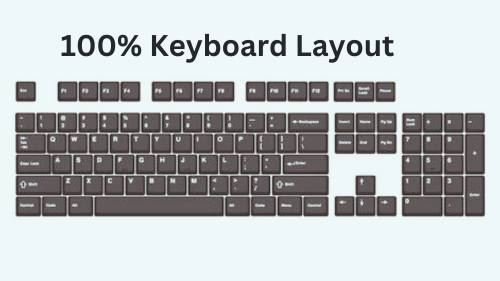
100% keyboards, or full size keyboards, are the most common type due to their comprehensive layout and versatility. They offer many features, including a numeric keypad, arrow keys, the primary key area, and a function area. This layout provides efficient data entry, precise cursor control, and seamless access to essential functions.
Missing Keys: None
Suitable scenarios: For content creation, Office use, data entry, Game, Programming
Recommended Keychron keyboards:
- Keychron K8: Premium mechanical keyboard with sleek aluminum frame and Cherry MX or Gateron switches for discerning typists and gamers.
- Keychron K10: Wireless mechanical keyboard with hot-swappable switches and Bluetooth connectivity for flexibility and convenience.
Fun fact: Having the number pad on the left can be more efficient for data entry, allowing you to keep your right hand on the arrow keys without lifting it when entering data into Excel.
| Advantages of 100% keyboards |
|---|
|
| Disadvantages of 100% keyboards |
|---|
|
96% | 100-Key Keyboard | Compact Full Size Mechanical Keyboard

96% keyboards, also known as compact full size keyboards, balance the comprehensive layout of 100% and smaller keyboards’ portability. They retain the essential keys for typing, data entry, gaming, and programming while eliminating the dedicated number pad, resulting in a slightly smaller form factor.
Missing Keys: Some navigation keys like PrtScn, Scroll Lock, and Pause
Suitable Scenarios:
- A rare find, like a unicorn!
- A middle ground between tenkeyless (TKL) and full-sized keyboards.
- Smushes together the number pad and the rest of the keyboard to save space.
- Slightly narrower and more compact than full-sized keyboards.
- It is for office use, gaming, programming, and general use.
Recommended Keychron Keyboards:
- Keychron K4: A versatile mechanical keyboard with a tenkeyless design, hot-swappable switches, RGB backlighting, balancing functionality, and portability.
- Keychron K2: A wireless mechanical keyboard with hot-swappable switches and Bluetooth connectivity, providing flexibility and convenience for both work and play.
| Advantages of 96% Keyboard |
|---|
|
| Disadvantages of 96% Keyboard |
|---|
|
80% | 87-key Keyboard | Tenkeyless Keyboard (TKL)
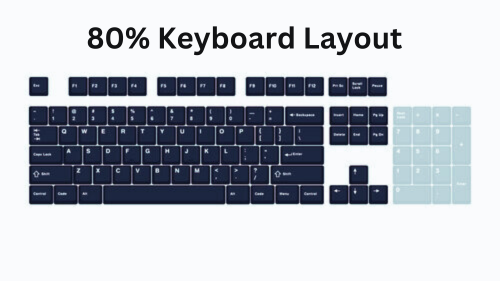
80% keyboards, also known as tenkeyless (TKL), offer a compact and versatile alternative to full-sized keyboards. They retain all essential keys for typing, data entry, and gaming while eliminating the dedicated number pad, resulting in a significantly smaller form factor. This makes them ideal for users who prioritize portability and desk space optimization.
Missing Keys: Number Pad
Suitable scenarios: Best for daily gaming and office use.
Recommended Keychron keyboards:
- Keychron V3: A versatile tenkeyless mechanical keyboard with hot-swappable switches, RGB backlighting, and various customizable options, making it a great choice for work and play.
- Keychron Q3: A premium tenkeyless mechanical keyboard with a gasket-mounted design, sound-dampening foam, and a choice of Cherry MX or Gateron switches, offering a superior typing experience for discerning typists.
| Advantages of 80% Keyboard |
|---|
|
| Disadvantages of 80% Keyboard |
|---|
|
75% | 84-keys keyboard | Compact Tenkeyless Keyboard

75 percent keyboard layout, also known as compact tenkeyless keyboards, offer a balance between the functionality of a full-sized keyboard and the portability of a tenkeyless keyboard. They retain all essential keys for typing, data entry, and gaming while eliminating the dedicated number pad and some less frequently used function keys. This results in a slightly smaller form factor, making them a good choice for users who want a more compact keyboard without sacrificing too much functionality.
Missing Keys: Number pad, some navigation keys (Insert, PrtScn, Scroll Lock, and Pause)
Suitable scenarios: Custom keyboard enthusiasts don’t need a number pad for daily office or gaming use.
Recommended Keychron keyboards:
- Keychron K6: A compact and versatile mechanical keyboard with a 75% layout, hot-swappable switches, and RGB backlighting.
- Keychron K8 Pro: A premium mechanical keyboard with a 75% layout, gasket-mounted design, sound-dampening foam, and Cherry MX or Gateron switches.
| Advantages of 75% Keyboard |
|---|
|
| Disdvantages of 75% Keyboard |
|---|
|
65% | 68-key keyboard | Compact Keyboard
65% keyboard layout, also known as compact keyboards, balance functionality, and portability. They retain all essential keys for typing, data entry, and gaming while eliminating some less frequently used function and navigation keys. This results in a significantly smaller form factor, making them ideal for users who want a more portable keyboard without sacrificing too much functionality.
Missing Keys: Number pad, some navigation keys (Del, End, Insert, PrtScn, Scroll Lock, and Pause), Function Keys
Suitable scenarios: For people who mainly need to type, use for gaming or office tasks that do not require processing of massive data, or for custom keyboard enthusiasts.
Recommended Keychron keyboard:
- Keychron K6 Pro: A compact and versatile 65% wireless mechanical keyboard with hot-swappable switches and RGB backlighting.
- Keychron Q2: A premium mechanical keyboard with a 65% layout, gasket-mounted design, sound-dampening foam, and Cherry MX or Gateron switches.
| Advatages of 65% keyboard |
|---|
|
| Disadvatages of 65% keyboard |
|---|
|
60% Keyboard | 61-key Keyboard | Mini Keyboard
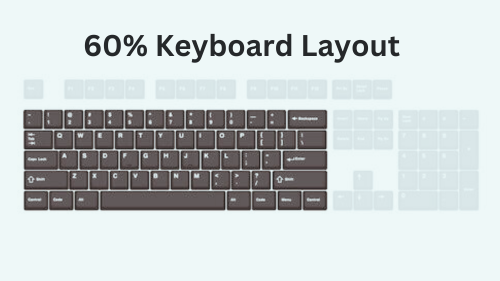
60% keyboards, or mini keyboards, are the smallest and most compact type of keyboard. They retain all essential keys for typing but eliminate most function, navigation, and editing keys. This results in a very small form factor, making them ideal for users who need a highly portable keyboard or who want to free up desk space.
Missing keys: Number pad, navigation keys, Function Keys, Arrow Keys
Suitable scenarios: People who mainly need to type and custom keyboard enthusiasts can easily use Office without editing massive amounts of data.
Recommended Keychron keyboard:
- Keychron K6 Pro: A compact and versatile mechanical keyboard with a 60% layout, hot-swappable switches, and RGB backlighting.
- Keychron Q1: A premium mechanical keyboard with a 60% layout, gasket-mounted design, sound-dampening foam, and Cherry MX or Gateron switches.
Choosing the Right Size for You:
So, how do you pick the perfect keyboard size? Here are some factors to consider:
- Desk space: Do you have a limited workspace? Opt for a TKL or even a smaller size.
- Primary use case:
- Gaming: TKL or 60% keyboards offer more mouse space.
- Data entry: A full-sized keyboard with a number pad is ideal.
- General purpose: Consider your comfort and how often you use specific keys (function keys, arrow keys).
- Personal preference: Do you prioritize minimalism or having all the keys readily available?
Conclusion:
Keyboard sizes vary widely, from full-sized keyboards with 104 keys to 60% with 61 keys. The smaller the keyboard, the fewer functional keys and navigation keys it has. The best types of keyboard sizes for you depend on your individual needs and preferences.
If you are a frequent typist or gamer, you may want to consider a keyboard with a dedicated number pad and dedicated editing keys. A smaller keyboard may be a better option if you have limited desk space or need a portable keyboard.
Ultimately, the best way to choose a keyboard size is to try different sizes and see what feels most comfortable.
Visit our website to browse our selection of keyboard Reviews in different sizes and layouts. We offer various options so you can find the perfect keyboard for your needs.
What are the 3 sizes of keyboards?
The three most common keyboard sizes are:
- Full-sized Keyboard (100%)
- Tenkeyless Keyboard (TKL) (80%)
- 60% Keyboard
What is the size of a normal keyboard?
There isn’t a single “normal” keyboard size. It depends on your needs and preferences. However, the most common size is the full-sized keyboard (100%) with 104 keys.
What is a 75% keyboard?
A 75% keyboard is compact and sits between a TKL (80%) and a 60% keyboard. It offers a 60% keyboard’s core keys with additional function keys like Delete or Insert for increased convenience.
What is the most popular keyboard size?
The most popular keyboard size is the full-sized keyboard (100%). However, Tenkeyless (TKL) keyboards are gaining popularity due to their space-saving design while offering the most essential keys.
What is the smallest keyboard size?
The smallest keyboard size is the 60% keyboard. It only features the core alphanumeric, modifier, and function row.
What are types of keyboard?
Beyond size, there are different types of keyboards, including:
- Membrane keyboards: Most common on laptops, they offer a quieter typing experience.
- Mechanical keyboards: Known for their tactile feedback and typing feel, gamers, and writers often prefer them.
- Ergonomic keyboards: Designed for comfort and to reduce strain on your wrists.
What are the 5 main functions of a keyboard?
The five main functions of a keyboard are:
- Text input: Typing letters, numbers, and symbols.
- Cursor movement: Use arrow keys and other keys to move the cursor on your screen.
- Performing actions: Function keys can be used for various actions depending on the program or operating system.
- Entering special characters: Keys like Shift and Alt Gr (on some keyboards) are used to access special characters.
- Using keyboard shortcuts: Combinations of keys can perform specific actions quickly.
How to choose a perfect keyboard size?
Is desk space tight? Try a TKL or 60% keyboard. Need a number pad? Go full-sized. Gamers or minimalists? TKL/60% might be good. Try different sizes if you can to find your perfect fit!
How many keys in computer keyboard?
The number of keys on a computer keyboard depends on the size. Here’s a quick breakdown:
- Full-sized keyboard (100%): Typically 104 keys
- Tenkeyless keyboard (TKL): Typically 87 keys
- 60% keyboard: Typically 61 keys
What does a keyboard look like?
A keyboard typically has a flat layout with rows of keys. These include:
- Alphanumeric keys (letters and numbers)
- Function keys (along the top)
- Modifier keys (like Ctrl, Shift, Alt)
- Space bar
- Potentially, a number pad and arrow keys
How many keys are on a full size keyboard?
A full-sized keyboard typically has 104 keys. This includes the alphanumeric keys (letters and numbers), function keys, modifier keys (like Ctrl, Shift, Alt), space bar, number pad, and arrow keys.tunesharemore_vert
How many switches in a 65 keyboard?
The number of key keys directly translates to the number of switches, assuming it’s not a specialty keyboard with non-standard key sizes or missing keys.
Therefore, a 65 keyboard typically has around 65 switches. It’s important to note that the exact number can vary slightly depending on the manufacturer’s layout choices (such as using a 1.5u key next to the spacebar instead of 1u keys).


